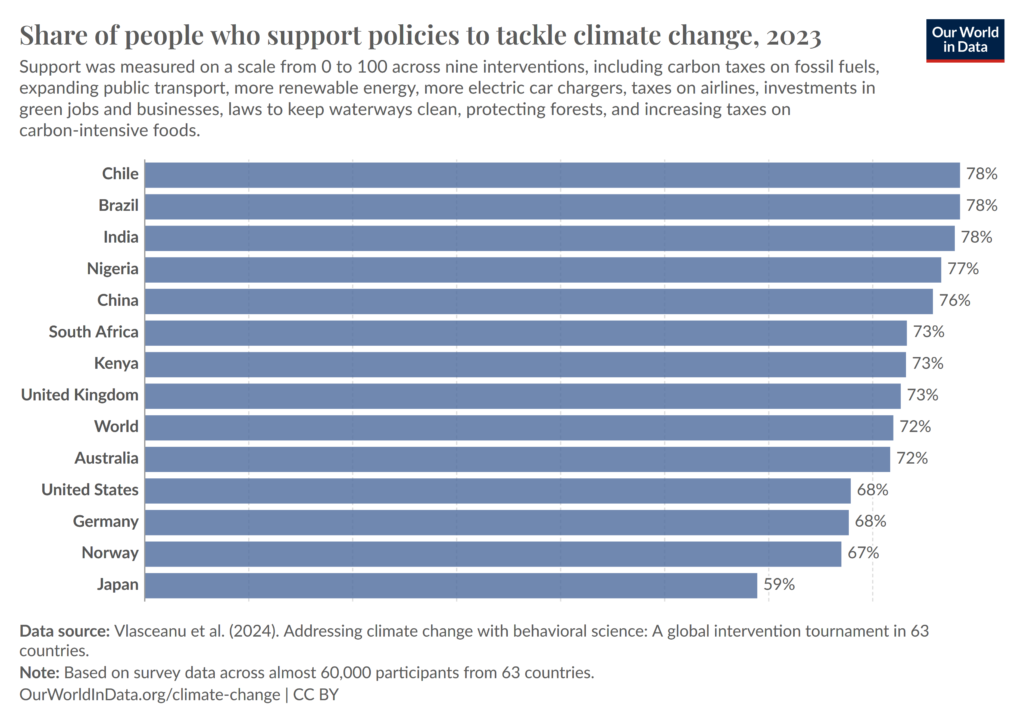Environmental awareness means understanding how we humans impact the environment and thus interact with various ecosystems. This interaction between humans and the environment can happen on multiple scales. Here, the term environmental awareness is used to describe the consciousness of people who perceive climate change as a threat and are willing to take climate action.
Climate Awareness: Climate change concerns most people
A recent study, published in Science Advances, found that most people across the world worry about climate change. In the graphic below you can see the share of people who believe climate change is a serious threat to humanity and that humans are the cause. The lowest level of agreement was measured in Israel at 73%, which is still pretty high. 1

Environmental awareness and climate policies
More surprisingly, the majority (72%) of the interviewed people supported climate policies, such as carbon taxes on fossil fuels, more renewable energy, and expanding public transport. Also in Japan, the country with the lowest acceptance of these policies, 59% of participants supported them. 1

Other studies found similar results: Peter Andre et al. (2024) interviewed 130,000 people across different countries. 89% of the participants said that they want to see more political action against climate change. 86% of them believe that people in their country “should try to fight global warming” (Andre et al., 2024). 2
However, in my perspective, it can make a difference whether you respond to a survey or are required to approve a climate policy that affects your daily life. For example, the majority of Germans (68%) agreed in the survey with laws protecting the climate. But this looks different in reality. The implementation of laws protecting the environment but affecting the budget of a social group or requiring people to change their habits often remains difficult. It is therefore very important to consider social issues when taking measures to combat climate change.
People underestimate the climate change awareness of others.
What is also interesting about the preceding data is that many people underestimate how much public support there is for climate action. The study by Andre et al. (2024) shows that 69% of the examined people would be willing to give 1% of their income to tackle climate change. But only 43% of the same participants assumed that others in their country would say “yes” to the same question. In fact, the respondents from each country misjudged the willingness to pay of their compatriots and hence their environmental awareness. 2
The results indicate a “perception gap” in the way we perceive our own climate views and those of others. But what causes this perception gap? Why do we tend to think that climate change is an important issue but also believe others don´t feel the same way. Ritchie and Roser argue (2024) that we might be individual optimists about supporting policies that protect us and future generations, but be pessimistic that others behave similarly. Social media and mainstream media could also influence this perception by creating polarizing but well-clicked content. 2
International Perceptions of Climate Policies
The OECD conducted a study with 40,000 participants across 20 of the world´s most carbon-emitting countries to investigate why climate policies remain difficult to implement. They came to the same conclusion as the studies mentioned above: There is broad agreement that climate change is a problem. However, the willingness to adopt behavioral changes to reduce emissions is limited. In particular, when it comes to climate policies such as limiting driving, beef consumption, and heating or cooling homes. On the website of the OECD, you can find an interactive chart where you can check out the acceptance of these individual restrictions. 3
The OECD proposes three solutions to this dilemma in order to help governments increase acceptance of climate policies. Firstly, it could be beneficial to accelerate the availability of low-carbon alternatives and provide infrastructure as well as subsidies to promote climate-friendly behavior. For example, making public transport more accessible and cheaper. Secondly, it is important to ensure that vulnerable groups are not affected more by climate policies than others. This particularly matters for energy taxation and carbon pricing. To prevent poorer households from being disproportionately affected by such measures, revenues from carbon taxation could be redistributed to these households. The incentive effect still applies. Thirdly, informing the public on how climate policies work can increase their acceptance. 3
Why is it important to talk about environmental awareness?
What can we learn from this data? We can talk more about specific solutions if we don´t have to convince people first that climate change is a problem. Moreover, the perception gap is important. Governments will adjust policies if they believe they have significant public support. Companies must acknowledge that customers expect to see low-carbon products and sustainable business strategies. Last but not least, the fight against climate change is a community project. We are more likely to change if we believe others will do too. 1
References:- Ritchie, H., Roser, M., 2024. More people care about climate change than you think. Our World in Data.
- Andre, P., Boneva, T., Chopra, F., Falk, A., 2024. Globally representative evidence on the actual and perceived support for climate action. Nature Climate Change 14, 1–7. https://doi.org/10.1038/s41558-024-01925-3
- OECD, n.d. International attitudes toward climate policies [WWW Document]. URL https://www.oecd.org/climate-change/international-attitudes-toward-climate-policies/ (accessed 3.31.24).

 To provide scientific knowledge on this site for free means a lot to me. However, researching and writing costs me a lot of time. Since I´m a student, financial support for my blog post helps me to maintain scientific quality.
To provide scientific knowledge on this site for free means a lot to me. However, researching and writing costs me a lot of time. Since I´m a student, financial support for my blog post helps me to maintain scientific quality.